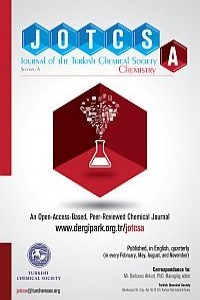Determination of Cd(II) Ions by using Cyclodextrin Based Polymeric Fluorescence Sensor
Determination of Cd(II) Ions by using Cyclodextrin Based Polymeric Fluorescence Sensor
In this study, Cd (II) ion was determined using a cyclodextrin-based polymeric fluorescence sensor prepared by UV-curing technique. The effects of several parameters such as pH, time, coexisting ions on the fluorescence intensity were also examined. The excitation and emission wavelengths were found to be 374 nm and 422 nm, respectively. The measurement range was in the range of 4.45x10-9 mol L-1 to 4.45x10-8 mol L-1 for Cd(II) ions and the detection limit was calculated as 6.23´10-10 mol L-1. In addition, sensor membrane was selective which was not influenced by common coexisting metal ions. The concentrations of the foreign ions such as Pb(II), Co(III), Ag(I), Zn(II), Cu(II), Cr(III) are 1000-fold higher than Cd(II) ions. Besides the prepared polymeric fluorescence sensor was successfully implemented to the determination of Cd(II)ions in biscuit and tap water samples.
Keywords:
Fluorescence sensor, photopolymerization, Cd(II) ions,
___
- 6. Daşbaşı T, Saçmacı Ş, Ülgen A, Kartal A. A solid phase extraction procedure for the determination of Cd(II) and Pb(II) ions in food and water samples by flame atomic absorption spectrometry. Food Chem. 2015; 174:591–596.
- 7. Feist B, Mikula B, Pytlakowska K, Puzio B, Buhl F. Determination of heavy metals by ICP-OES and F-AAS after preconcentration with 2,2´-bipyridyl and erythrosine. J. Hazard. Mater. 2008; 152: 1122–1129. DOI: 10.1016/j.jhazmat.2007.07.095.
- 8. Ghaemi A, Tavakkoli H, Mombeni T. Fabrication of a Highly Selective Cadmium (II) Sensor Based on 1,13-bis(8quinolyl)-1,4,7,10,13-pentaoxatridecane as a supramolecular ionophore, Mater. Sci. Eng. 2014; 38:186-191. DOI: 10.1016/j.msec.2014.02.006.
- 9. Ivari ASR, Darroudi A. Ion Imprinted Polymer Based Potentiometric Sensor for the Trace Determination of Cadmium (II) Ions. Arabian J. Chem. 2013. DOI: 10.1016/j.arabjc.2012.12.021.
- Khani R, Ghiamati E, Boroujerdi R, Rezaeifard A, Zaryabi MH. A new and highly selective turn-on fluorescent sensorwith fast response time for the monitoring of cadmium ions in cosmetic, and health product samples. Spectrochim. Acta, Part A. 2016; 163:120–126. DOI: 10.1016/j.saa.2016.03.011.
- 1. Robards K, Worsfold P. Cadmium: toxicology and analysis. A review. The Analyst. 1991;116(6):549.
- 2. Ulah MR, Enamul Haque M. Spectrophotometric Determination Of Toxic Elements(Cadmium) In Aqueous Media. J. Chem. Eng. 2010; 25(1):1-12. DOI: 10.3329/jce.v25i0.7233.
- 3. Bulgariu L, Bulgariu D, Sarghie I. Spectrophotometric Determination of Cadmium(II) Using p,p′‐Dinitro‐SYM‐Diphenylcarbazid in Aqueous Solution. Anal. Lett. 2005; 38: 2365–2375. DOI:10.1080/00032710500316597.
- 4. Zougagh M, Garcia de Torres A, Cano Pavon JM. Determination of cadmium in water by ICP-AES with on-line adsorption preconcentration using DPTH-gel and TS-gel microcolumns. Talanta. 2002; 56: 753–761. DOI: 10.1016/S0039-9140(01)00605-1.
- 5. Constantin M, Bucatariu S, Ascenzi P, Simionescu BC, Fundueanu G. Poly(NIPAAm-co-β-cyclodextrin) Microgels with Drug Hosting and Temperature-Dependent Delivery Properties. React. Funct. Polym. 2014; 84: 1-9.
- 6. BS EN 13804:2013; Foodstuffs. Determination of elements and their chemical species. General considerations and specific requirements.2013. ISBN: 9780580764127.
- 7. Demir S, Kahraman MV, Bora N, Kayaman Apohan N, Ogan A. Preparation, Characterization, and Drug Release Properties of Poly(2-hydroxyethyl methacrylate) Hydrogels having β -Cyclodextrin Functionality. J. Appl. Polym. Sci. 2008; 109:1360–1368.DOI: 10.1002/app.28284.
- Bulgariu L, Bulgariu D, Sarghie I. Spectrophotometric Determination of Cadmium(II) Using p,p′‐Dinitro‐SYM‐Diphenylcarbazid in Aqueous Solution. Anal. Lett. 2005; 38: 2365–2375. DOI:10.1080/00032710500316597.
- Zougagh M, Garcia de Torres A, Cano Pavon JM. Determination of cadmium in water by ICP-AES with on-line adsorption preconcentration using DPTH-gel and TS-gel microcolumns. Talanta. 2002; 56: 753–761. DOI: 10.1016/S0039-9140(01)00605-1.
- Constantin M, Bucatariu S, Ascenzi P, Simionescu BC, Fundueanu G. Poly(NIPAAm-co-β-cyclodextrin) Microgels with Drug Hosting and Temperature-Dependent Delivery Properties. React. Funct. Polym. 2014; 84: 1-9.
- BS EN 13804:2013; Foodstuffs. Determination of elements and their chemical species. General considerations and specific requirements.2013. ISBN: 9780580764127.
- Demir S, Kahraman MV, Bora N, Kayaman Apohan N, Ogan A. Preparation, Characterization, and Drug Release Properties of Poly(2-hydroxyethyl methacrylate) Hydrogels having β -Cyclodextrin Functionality. J. Appl. Polym. Sci. 2008; 109:1360–1368.DOI: 10.1002/app.28284.
- Başlangıç: 2014
- Yayıncı: Türkiye Kimya Derneği
Sayıdaki Diğer Makaleler
Sarra SIBOUS, Said BOUKHRIS, Rachida GHAILANE, Nouzha HABBADI, Amina HASSIKOU, Abdelaziz SOUIZI
Chemical investigation and antioxidant activity of fractions of Lannea humilis (Oliv.) Engl.
Jonathan ACHIKA, Racheal AYO, Adebayo OYEWALE, Dama JAMES
Determination of Cd(II) Ions by using Cyclodextrin Based Polymeric Fluorescence Sensor
Soner ÇUBUK, Özge YILMAZ, Ece KÖK YETİMOĞLU, Memet Vezir KAHRAMAN
Soner ÇUBUK, Mirgül KOSİF, Ece KÖK YETİMOĞLU, Memet Vezir KAHRAMAN
